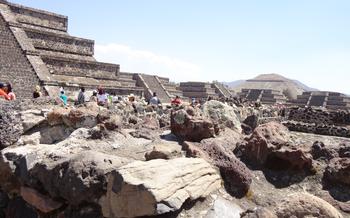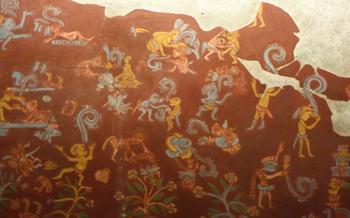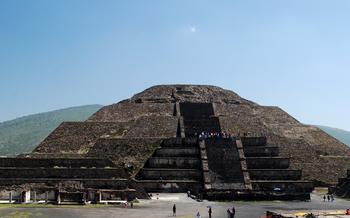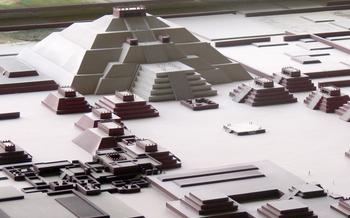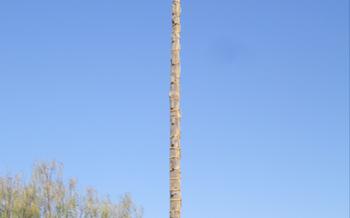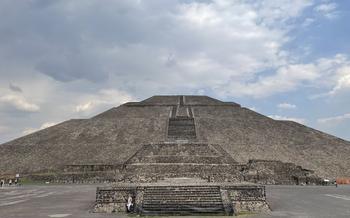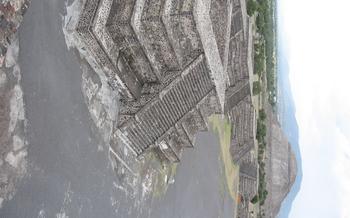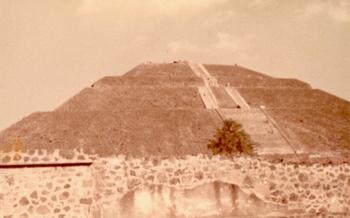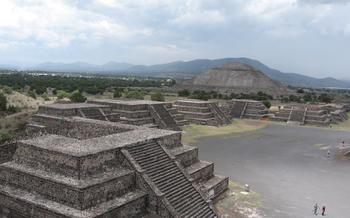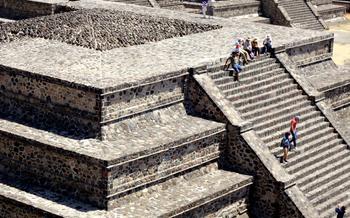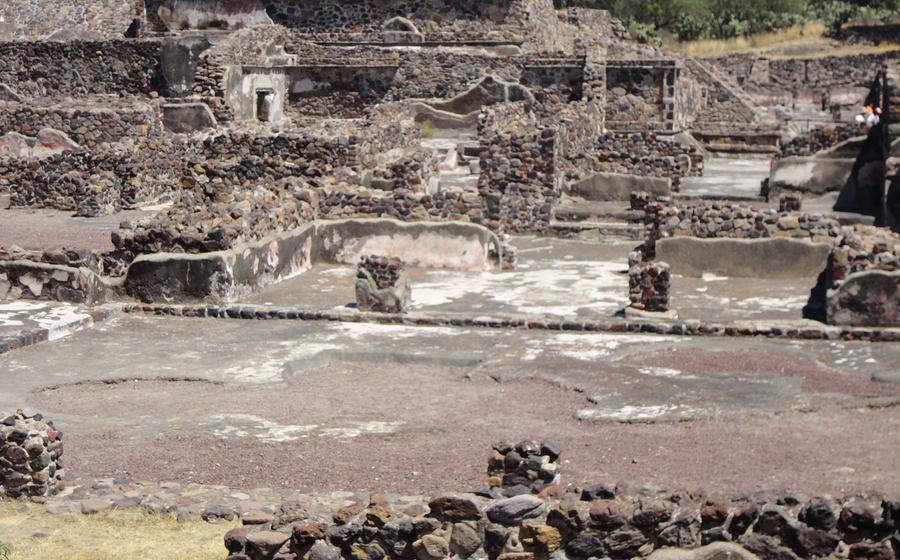
Ciudadela
- Historical Significance
- Architectural Wonders
- Murals and Paintings
- Temples and Altars
- Exploration and Discovery
- Local Culture and Traditions
- Interactive Experiences
- Natural Beauty
- Best Time to Visit
- Getting There and Around
- Entrance Fees and Hours of Operation
- What to Wear and Bring
- Food and Dining Options
- Safety and Precautions
- Insider Tip: Unveiling the Hidden Treasures of Teotihuacan
Historical Significance
Teotihuacan, a sprawling metropolis in pre-Columbian Mesoamerica, flourished between the 1st and 7th centuries AD. Its grandeur was centered around the Ciudadela, a ceremonial complex that housed some of the most iconic landmarks of the ancient city. The Pyramid of the Sun, a colossal structure rising over 200 feet, stands as a testament to Teotihuacan's architectural prowess. This marvel of engineering, aligned with the stars, served as a sacred temple and the focal point of religious rituals. The Ciudadela also embraced the Pyramid of the Moon, a smaller yet equally impressive edifice, along with the Avenue of the Dead, a broad boulevard connecting the two pyramids and symbolizing the city's central axis.
The cultural and religious significance of Teotihuacan extended far beyond its physical grandeur. The city was a thriving hub of trade and cultural exchange, attracting pilgrims, merchants, and artisans from across Mesoamerica. Its influence can be seen in the widespread adoption of Teotihuacan's artistic motifs, religious practices, and urban planning in other Mesoamerican cultures. In recognition of its exceptional value, UNESCO designated Teotihuacan as a World Heritage Site, ensuring its preservation and continued appreciation by future generations.
Architectural Wonders
At the heart of the ancient city of Teotihuacan, two awe-inspiring pyramids stand tall, testaments to the architectural prowess of its people. The Pyramid of the Sun, the largest structure in Teotihuacan, rises majestically at 75 meters high. Constructed using adobe bricks and faced with stone, it is a marvel of engineering and a symbol of the city's power and grandeur. The pyramid's four sides are aligned with the cardinal directions, and its staircase leads to a platform at the summit, offering breathtaking panoramic views of the surrounding landscape.
While smaller in size, the Pyramid of the Moon is equally impressive. Measuring 42 meters in height, it features a unique architectural element known as the "talud-tablero" design, characterized by alternating sloping and vertical sections. The pyramid's summit platform also offers stunning views, including the Avenue of the Dead, the main thoroughfare of Teotihuacan, which connects the two pyramids and serves as the central axis of the city's urban layout.
Murals and Paintings
Teotihuacan's vibrant and colorful murals are a testament to the artistic prowess of its ancient inhabitants. Depicting mythical creatures, gods, and scenes from everyday life, these murals offer a glimpse into the beliefs, rituals, and imagination of the Teotihuacanos. The most famous murals are found in the Temple of Quetzalcoatl, where the Feathered Serpent is depicted in all its glory, surrounded by intricate geometric patterns and symbolic imagery. Archaeological excavations have uncovered numerous other murals throughout the site, providing valuable insights into the cultural and religious life of this ancient city. Ongoing research continues to shed light on the significance of these artworks, revealing their profound symbolism and connection to the spiritual and cosmological beliefs of the Teotihuacanos.
Temples and Altars
Teotihuacan's sacred structures, particularly the Temple of Quetzalcoatl and the Temple of the Feathered Shells, stand as testaments to the city's intricate religious beliefs and practices. The Temple of Quetzalcoatl, also known as the Temple of the Plumed Serpent, is adorned with intricate carvings depicting the feathered deity himself, along with other mythical figures and symbols. These carvings offer a glimpse into the complex mythology and religious rituals that took place within these sacred spaces.
The Temple of the Feathered Shells, named for the unique seashell-shaped motifs adorning its facade, exhibits a distinct architectural style. Its design incorporates elements of both Teotihuacan and Maya architecture, hinting at the cultural exchange and influences that shaped the city. Within these temples, elaborate altars once served as focal points for religious ceremonies and rituals. These altars, often decorated with colorful murals and offerings, were believed to be gateways between the physical and spiritual realms.
Excavations at Teotihuacan have revealed a wealth of artifacts, including ceremonial objects, incense burners, and sacrificial offerings, providing insights into the rituals and beliefs of the ancient inhabitants. The exploration of these temples and altars continues to shed light on the profound spiritual significance of Teotihuacan, enriching our understanding of this ancient civilization's complex religious practices.
Exploration and Discovery
Teotihuacan has been a site of fascination and intrigue for archaeologists and historians for centuries. Excavations have unearthed countless artifacts, murals, and sculptures that shed light on the city's ancient inhabitants and their way of life. Ongoing archaeological projects, often conducted in collaboration with international teams, continue to uncover new insights and mysteries about this remarkable city.
One of the most exciting aspects of Teotihuacan is the sense of discovery that visitors can experience. Walking through the ancient streets and exploring the ruins, one can't help but feel a sense of awe and wonder at the accomplishments of this ancient civilization. It's truly a place where history comes alive, and visitors can feel like they're part of an ongoing journey of exploration and discovery.
Local Culture and Traditions
Teotihuacan's legacy extends beyond its architectural marvels to encompass the vibrant culture and traditions of the local indigenous communities. San Juan Teotihuacan, nestled at the foot of the ancient city, offers a glimpse into the rich heritage of the region.
The annual Fiesta de San Juan Bautista, held in June, is a colorful spectacle that honors the patron saint of the town. The streets come alive with processions, traditional dances, and music, showcasing the deep-rooted traditions of the Nahua people.
Visitors can immerse themselves in the local culture by interacting with the artisans who create intricate pottery, woven textiles, and other traditional crafts. These artisans keep alive the ancient techniques and designs passed down through generations.
Cultural exchange and interactions with the local people are encouraged, providing a unique opportunity to learn about their way of life, beliefs, and customs. The warmth and hospitality of the community make visitors feel welcome and respected.
Interactive Experiences
At Teotihuacan, you can immerse yourself in the ancient culture through a variety of interactive experiences. Guided tours led by expert archaeologists and historians offer a wealth of knowledge and insights into the site's history, architecture, and significance. These tours often include access to restricted areas and provide up-close encounters with the pyramids, murals, and temples.
For a more hands-on experience, participate in pottery-making workshops and learn the traditional techniques used by ancient artisans. Create your masterpiece using local clay and traditional tools, and take home a unique souvenir crafted by your own hands.
Enhance your exploration with immersive cultural experiences. Attend traditional festivals and celebrations that honor the city's ancient heritage, such as the annual Festival of the Dead (Día de los Muertos), where you can witness colorful parades, vibrant altars, and traditional rituals. Engage with the local indigenous communities of San Juan Teotihuacan, and learn about their customs, traditions, and way of life.
Natural Beauty
Teotihuacan is nestled within a captivating semi-arid landscape, a testament to the resilience and adaptability of ancient civilizations. The surrounding hills and valleys, dotted with cacti and scrubland, create a unique backdrop for the awe-inspiring pyramids and temples. This arid environment, once a challenge for the Teotihuacanos, has now become an integral part of the site's charm.
The region boasts a diverse array of flora and fauna, adding to the overall allure of Teotihuacan. Keep an eye out for the iconic maguey plants, also known as century plants, with their towering stalks and vibrant green leaves. The prickly pear cactus, with its colorful fruits, is another common sight. Bird enthusiasts will delight in the variety of species that call this ecosystem home, from hummingbirds and mockingbirds to hawks and falcons.
For those seeking a more active experience, hiking trails wind through the surrounding hills, offering panoramic views of the ancient city and the surrounding countryside. The trails vary in difficulty, catering to hikers of all levels. As you wander along these paths, you'll encounter hidden nooks and crannies, adding an element of discovery to your exploration.
Best Time to Visit
To fully appreciate the splendor of Teotihuacan, timing is essential. The best period to visit is during the shoulder seasons, from late September to early November and from late March to early May. During these months, the weather is pleasant, with moderate temperatures and fewer crowds, allowing for a more intimate exploration of the ancient city.
However, if you're looking for a vibrant atmosphere and the chance to witness traditional festivals, plan your trip around one of the many cultural events held throughout the year. The annual Festival of the Dead (Día de los Muertos) in early November is a particularly special time to visit, as the city comes alive with colorful altars, parades, and celebrations honoring the deceased.
To avoid the peak tourist season and scorching summer heat, it's best to steer clear of the months from December to February, especially during the Christmas and New Year holidays. Also, keep in mind that the site is closed on Mondays, so plan your visit accordingly.
Getting There and Around
Reaching Teotihuacan from Mexico City is a breeze, with various transportation options available. You can hop on a comfortable bus from the Central Norte bus station, which takes about an hour and costs around $5-For a more scenic journey, opt for the turístico train that departs from Buenavista train station and offers stunning views of the countryside. The ride takes approximately an hour and a half and costs around $10-
If you prefer the flexibility of exploring at your own pace, renting a car is a great option. The drive from Mexico City takes about an hour, and you'll have the freedom to stop along the way to admire the surrounding landscapes. Car rental rates start from around $30 per day.
Once in Teotihuacan, the best way to get around is on foot. The archaeological site is relatively compact, and the main attractions are within easy walking distance of each other. However, if you're short on time or prefer a more leisurely exploration, you can rent a bicycle or hire a local guide who can provide insights into the site's history and significance.
Entrance Fees and Hours of Operation
Visiting Teotihuacan is an affordable and accessible experience. The current admission price for international visitors is [Admission fee], with discounts available for students, seniors, and children. It's advisable to purchase tickets online or at the entrance to avoid long queues, especially during peak tourist season.
The site operates daily, with hours varying slightly depending on the time of year. Generally, it opens from 9:00 AM to 5:00 PM, but it's worth checking the official website for the most up-to-date information. Keep in mind that the best time to visit is early in the morning or late in the afternoon to avoid the midday heat and crowds.
What to Wear and Bring
When visiting Teotihuacan, it's essential to dress appropriately for the weather and the terrain. The ancient city is located in a semi-arid region, so temperatures can be high during the day, especially during the summer months. Lightweight, breathable clothing and comfortable shoes are recommended. Avoid wearing flip-flops or sandals, as the uneven ground can be treacherous.
Sun protection is a must, so don't forget your hat, sunglasses, and sunscreen. It's also a good idea to bring a water bottle and snacks, as there are limited food options within the archaeological site.
To fully appreciate the grandeur of Teotihuacan, consider bringing a camera to capture the stunning views and intricate details of the pyramids and murals. Binoculars can also be helpful for getting a closer look at the distant structures and the surrounding landscape.
In addition, remember to bring any medications you may need, as well as a small first-aid kit for minor injuries or discomfort.
Food and Dining Options
Immerse yourself in the flavors of Mexico at the local restaurants surrounding Teotihuacan. Indulge in traditional delicacies like tacos, enchiladas, and tamales, prepared with fresh, local ingredients. Sample the region's famous barbacoa, a slow-cooked lamb or goat dish that is a culinary delight.
For a unique experience, pack a picnic lunch and enjoy it amidst the ancient ruins. Spread out a blanket under the shade of a tree and savor the flavors of homemade sandwiches, salads, and fresh fruit while surrounded by history.
If you prefer a quick bite, food vendors and street stalls offer a variety of snacks and drinks. Try the local favorites like elote (grilled corn on the cob), esquites (corn in a cup), or tlayudas (large, crispy tortillas topped with beans, cheese, and various fillings).
Remember to hydrate by bringing your own water or purchasing from local vendors. Whether you choose to dine at a restaurant, picnic in the ruins, or grab a quick bite from a street vendor, the culinary experiences in Teotihuacan are as rich and diverse as the city itself.
Safety and Precautions
As with any popular tourist destination, it's important to be aware of your surroundings and take necessary precautions to ensure a safe and enjoyable visit to Teotihuacan. While the city is generally safe, petty theft and scams can occur, particularly in crowded areas. Be wary of individuals trying to sell you souvenirs or offering unsolicited services. It's advisable to keep your valuables secure and avoid carrying large amounts of cash. Additionally, respect local customs and traditions by dressing modestly and behaving respectfully. By exercising caution and common sense, you can fully immerse yourself in the wonders of Teotihuacan without compromising your safety.
Insider Tip: Unveiling the Hidden Treasures of Teotihuacan
Beyond the main attractions, Teotihuacan holds a treasure trove of hidden gems waiting to be discovered. Venture off the beaten path to explore lesser-known temples and plazas, each with its own unique charm and historical significance. Ascend the Pyramid of the Moon for breathtaking panoramic views of the entire site. Uncover the secrets of the ancient ball courts, where Mesoamerican civilizations played a ritual game with deep cultural and religious symbolism. Discover the hidden tunnels beneath the Pyramid of the Sun, believed to have been used for ceremonial purposes. With a keen eye and a sense of adventure, you'll uncover the magic that lies beyond the surface of Teotihuacan.
